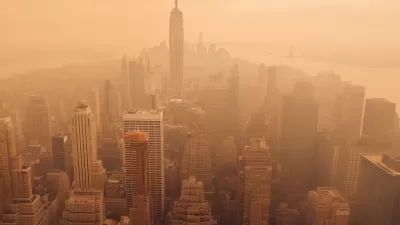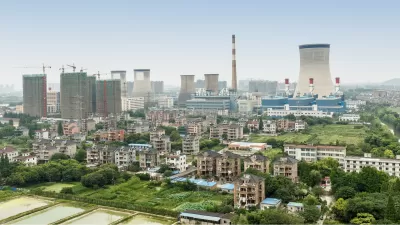A new study reveals two findings on air pollution spewing from China's coal-burning factories. First, the pollution blows to the U.S and other nations. Second, 20% of the pollution can be traced to Western demand for cheap goods from those factories.
"About one-fifth of the pollution China spews into the atmosphere comes from producing goods for export to the United States and other countries, according to the paper [PDF] by a group of scientists that was published [Jan. 20] in the Proceedings of the National Academy of Sciences (PNAS)," writes Tony Barboza.
In six days, winds can blow the smog and particulates that cloak China's eastern cities to the U.S and "spread pollution levels over the West Coast of up to 75 percent of federal standards," writes John Metcalfe of The Atlantic Cities.
These transported pollutants explain why air pollution levels "have remained at a high level during 2000–2009 even as emissions produced in the United States, Europe, and Japan have decreased,” the scientists wrote.
The paper is a reminder that U.S. demand for cheap imports from China has a way of blowing those environmental problems back at us, said Steve Davis, an Earth system scientist at UC Irvine and co-author of the study.
In The New York Times, Edward Wong writes that Jintai Lin, a professor in the department of atmospheric and oceanic sciences at Peking University’s School of Physics and lead author of the paper, "said he hoped that the research would stimulate discussion of adopting consumption-based accounting of emissions, rather than just production-based accounting."
Davis went beyond air pollution and linked the report to climate change, expressing "hope that the findings would be used by world governments working to craft international agreements to limit emissions of carbon dioxide...as well as short-lived air pollutants that are responsible for poor air quality around the globe."
Wong notes that last July, PNAS "published a paper by other researchers that found a drop in life spans in northern China because of air pollution," also posted here.
FULL STORY: China's industry exporting air pollution to U.S., study says

Maui's Vacation Rental Debate Turns Ugly
Verbal attacks, misinformation campaigns and fistfights plague a high-stakes debate to convert thousands of vacation rentals into long-term housing.

Planetizen Federal Action Tracker
A weekly monitor of how Trump’s orders and actions are impacting planners and planning in America.

In Urban Planning, AI Prompting Could be the New Design Thinking
Creativity has long been key to great urban design. What if we see AI as our new creative partner?

Cal Fire Chatbot Fails to Answer Basic Questions
An AI chatbot designed to provide information about wildfires can’t answer questions about evacuation orders, among other problems.

What Happens if Trump Kills Section 8?
The Trump admin aims to slash federal rental aid by nearly half and shift distribution to states. Experts warn this could spike homelessness and destabilize communities nationwide.

Sean Duffy Targets Rainbow Crosswalks in Road Safety Efforts
Despite evidence that colorful crosswalks actually improve intersection safety — and the lack of almost any crosswalks at all on the nation’s most dangerous arterial roads — U.S. Transportation Secretary Duffy is calling on states to remove them.
Urban Design for Planners 1: Software Tools
This six-course series explores essential urban design concepts using open source software and equips planners with the tools they need to participate fully in the urban design process.
Planning for Universal Design
Learn the tools for implementing Universal Design in planning regulations.
Appalachian Highlands Housing Partners
Gallatin County Department of Planning & Community Development
Heyer Gruel & Associates PA
Mpact (founded as Rail~Volution)
City of Camden Redevelopment Agency
City of Astoria
City of Portland
City of Laramie





























